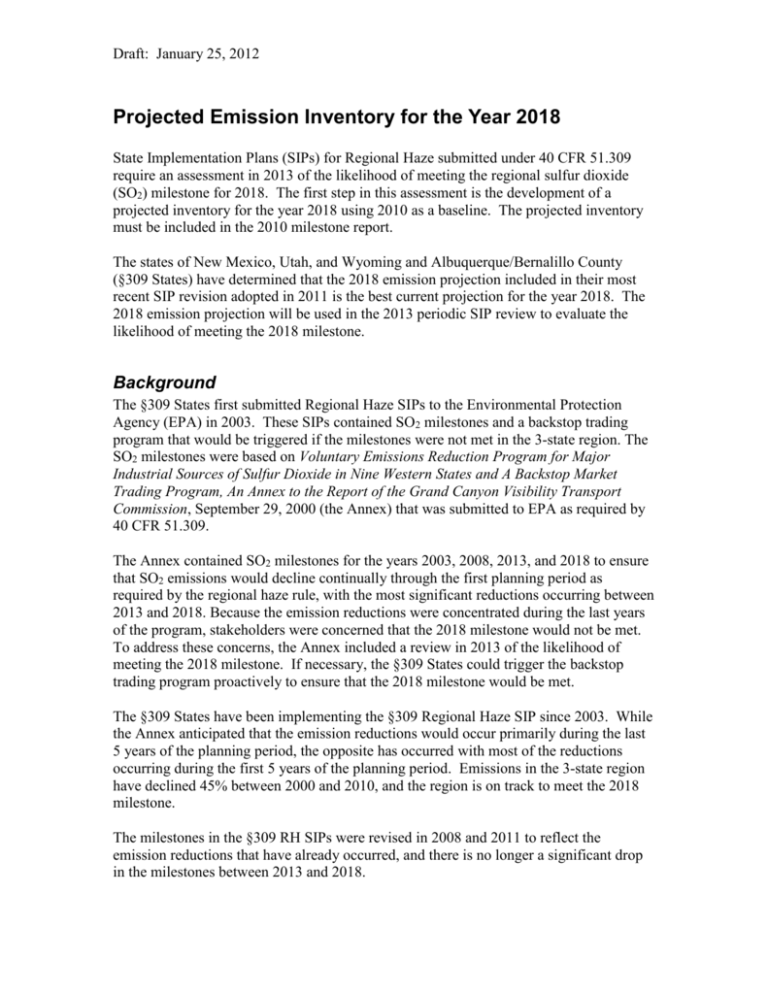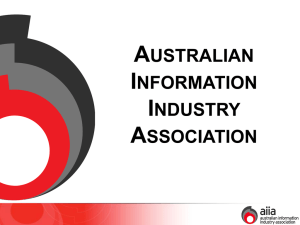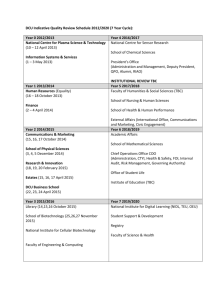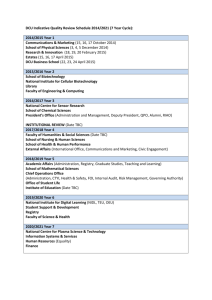Projected Emission Inventory for the Year 2018
advertisement

Draft: January 25, 2012 Projected Emission Inventory for the Year 2018 State Implementation Plans (SIPs) for Regional Haze submitted under 40 CFR 51.309 require an assessment in 2013 of the likelihood of meeting the regional sulfur dioxide (SO2) milestone for 2018. The first step in this assessment is the development of a projected inventory for the year 2018 using 2010 as a baseline. The projected inventory must be included in the 2010 milestone report. The states of New Mexico, Utah, and Wyoming and Albuquerque/Bernalillo County (§309 States) have determined that the 2018 emission projection included in their most recent SIP revision adopted in 2011 is the best current projection for the year 2018. The 2018 emission projection will be used in the 2013 periodic SIP review to evaluate the likelihood of meeting the 2018 milestone. Background The §309 States first submitted Regional Haze SIPs to the Environmental Protection Agency (EPA) in 2003. These SIPs contained SO2 milestones and a backstop trading program that would be triggered if the milestones were not met in the 3-state region. The SO2 milestones were based on Voluntary Emissions Reduction Program for Major Industrial Sources of Sulfur Dioxide in Nine Western States and A Backstop Market Trading Program, An Annex to the Report of the Grand Canyon Visibility Transport Commission, September 29, 2000 (the Annex) that was submitted to EPA as required by 40 CFR 51.309. The Annex contained SO2 milestones for the years 2003, 2008, 2013, and 2018 to ensure that SO2 emissions would decline continually through the first planning period as required by the regional haze rule, with the most significant reductions occurring between 2013 and 2018. Because the emission reductions were concentrated during the last years of the program, stakeholders were concerned that the 2018 milestone would not be met. To address these concerns, the Annex included a review in 2013 of the likelihood of meeting the 2018 milestone. If necessary, the §309 States could trigger the backstop trading program proactively to ensure that the 2018 milestone would be met. The §309 States have been implementing the §309 Regional Haze SIP since 2003. While the Annex anticipated that the emission reductions would occur primarily during the last 5 years of the planning period, the opposite has occurred with most of the reductions occurring during the first 5 years of the planning period. Emissions in the 3-state region have declined 45% between 2000 and 2010, and the region is on track to meet the 2018 milestone. The milestones in the §309 RH SIPs were revised in 2008 and 2011 to reflect the emission reductions that have already occurred, and there is no longer a significant drop in the milestones between 2013 and 2018. Draft: January 25, 2012 2011 SIP Revision The §309 States have recently revised their RH SIPs to update the SO2 milestones. These revisions were completed in 2011 and included a projected 2018 inventory. The projected inventory was based on the 2018 PRPb inventory developed by the Western Regional Air Partnership (WRAP) to support Regional Haze SIPs in the region. This inventory was reviewed, and additional changes were made to include updated oil and gas projections from the WRAP Phase II oil and gas inventory as well as source-specific updates due to new permit limits. Shut down sources were removed from the inventory and new sources were added to reflect the best available information. Potential Changes Between 2010 and 2018 There are a number of national measures that may further reduce SO2 emissions between 2010 and 2018. EPA has recently proposed New Source Performance Standards for the oil and gas industry that may reduce emission in the 3-state region. In addition, revised National Ambient Air Quality Standards for SO2 may require reductions from the large source of SO2 that are included in the milestones. The §309 States do not currently anticipate any changes to the assumptions in the 2018 projections that would lead to higher than anticipated emissions growth between 2010 and 2018. Draft: January 25, 2012 Conclusion The §309 States have determined that the 2018 emission projection included in their most recent SIP revision adopted in 2011 is the best current projection for the year 2018. The 2018 emission projection will be used in the 2013 periodic SIP review to evaluate the likelihood of meeting the 2018 milestone.







